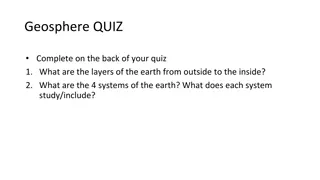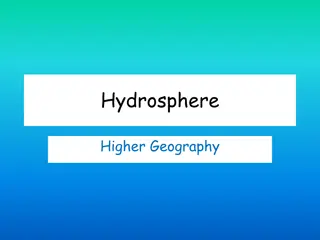Earth's Geosphere, Hydrosphere, and Biosphere
Explore the layers of the Earth, its systems, the hydrosphere including the water cycle, and the importance of Earth's oceans through informative content and images presented in this overview.
2 views • 30 slides
Drainage Basins in the Hydrosphere
Explore the concept of drainage basins in the context of the hydrosphere. Learn about the components, movement of water, and key elements within drainage basins. Understand how water moves through these systems and factors that influence them, such as precipitation and storage capacity.
0 views • 18 slides
The Components and Types of Environmental Pollution
The environment comprises abiotic and biotic elements, including the atmosphere, hydrosphere, lithosphere, and biosphere. Different types of pollution, such as air, water, land/soil, noise, and thermal pollution, pose significant threats to human health and the environment. Awareness of these pollut
1 views • 17 slides
Convection Currents in Earth's Systems
Convection currents refer to the movement of heat by fluids like liquids and gases, transferring heat from one place to another. They play a significant role in the geosphere, atmosphere, and hydrosphere of the Earth, influencing phenomena such as plate tectonics, winds, and ocean currents. In the g
0 views • 12 slides
Geography: Earth's Description and Study
Geography, coined by Greek scholar Eratosthenes, encompasses the description and explanation of Earth's surface differentiation. It involves physical and human aspects, with branches like geomorphology, climatology, and economic geography. Physical geography studies the lithosphere, atmosphere, hydr
0 views • 6 slides
Components of the Environment in Social Science Chapter 1
The components of the environment play a crucial role in supporting life on Earth. The natural environment consists of physical and biological components that are interdependent. The Earth can be divided into four spheres: hydrosphere, biosphere, atmosphere, and lithosphere. The lithosphere, made of
3 views • 16 slides
Processes Shaping Earth: Lithosphere, Plate Tectonics, and Effects
Explore the components of our planet, such as the lithosphere, hydrosphere, atmosphere, and biosphere. Learn how the lithosphere, consisting of the Earth's crust and top solid mantle, interacts through plate tectonics, causing movements that shape the Earth's surface. Discover the concept of Pangaea
0 views • 31 slides
Ecosystems: Components and Interactions
Ecosystems are dynamic systems where abiotic and biotic components interact to sustain life. Ecology studies these interactions, including nutrient cycling and energy flow. The biosphere, comprising the atmosphere, hydrosphere, lithosphere, and living organisms, forms Earth's life-support system. Ec
0 views • 22 slides
Natural Vegetation and Wildlife Resources
Natural vegetation and wildlife play a crucial role in the biosphere, providing essential resources and maintaining ecological balance. The interaction between the lithosphere, hydrosphere, and atmosphere creates the biosphere where living organisms thrive. Plants offer timber, oxygen, and other val
0 views • 16 slides
The Earth's Environmental Systems and Cycles
Explore the interconnected systems of the Earth's biosphere, lithosphere, hydrosphere, and atmosphere, along with biogeochemical cycles like the hydrological cycle. Learn how these systems interact to sustain life and maintain Earth's dynamic environment over billions of years.
1 views • 28 slides
The Fascinating World of Geology and Earth Sciences
Delve into the diverse field of geology, covering topics such as physical and historical geology, geochronology, mineralogy, petrology, and more. Learn about the solar nebula hypothesis and the Earth's lithosphere, hydrosphere, atmosphere, and biosphere. Discover the composition of Earth's atmospher
0 views • 12 slides
The Hydrologic Cycle and Water Distribution
The hydrologic cycle, water distribution in the hydrosphere, water usage in the United States in 2005, condensation processes forming fog, cloud types, precipitation processes including ice-crystal and coalescence processes, and types of precipitation like sleet, freezing rain, hail, and graupel are
1 views • 30 slides
Earthquakes and Seismic Waves
This lecture delves into the nature and origin of earthquakes, discussing seismic waves, measurement techniques, effects of earthquakes on various Earth systems, and the relationship between earthquakes and plate tectonics. The content touches on topics like the impact of earthquakes on biosphere, h
0 views • 34 slides
Hydrological Cycle and Aquatic Environments
Dive into the fascinating world of the hydrosphere with a comprehensive look at the hydrological cycle, water properties, hydrology, salinity, aquatic biomes, and ocean facts. Discover how water moves through Earth's spheres, the distribution of freshwater, the significance of oceans, and their role
0 views • 31 slides
Fundamental Concepts of Geomorphology: Exploring Earth Forms and Evolution
Geomorphology, derived from Greek roots for earth and study, focuses on the origin and evolution of Earth's surface features. Geomorphologists study landforms above sea level and the interface between solid Earth, Hydrosphere, atmosphere, and Lithosphere. The fundamental concepts of geomorphology in
0 views • 12 slides
Introduction to Ecology and Environment Studies
Ecology is the study of the relationship between organisms and their environment, while the environment refers to the surroundings that influence living organisms. The biosphere is divided into the atmosphere, lithosphere, and hydrosphere. Terms in ecology include species, populations, communities,
0 views • 13 slides
Introduction to Earth Systems in GEO101 Spring 2023
Explore the fundamental concepts of Earth systems in GEO101 Spring 2023, covering the components, linkages, states, and examples of systems such as Atmosphere, Lithosphere, Hydrosphere, and Biosphere. Gain insight into the interconnections and dynamics of these systems to understand the complexity o
0 views • 30 slides
The Hydrological Cycle in Geography Education
Delve into the intricacies of the hydrological cycle within the hydrosphere, learning about the processes, factors, and impacts associated with water movement in urban and rural areas. Explore the concept of hydrology, drainage basins, hydrographs, and the water cycle powered by the sun. Enhance you
0 views • 24 slides
Interactions Among Earth's Systems
Explore the interconnectedness of Earth's systems including the geosphere, biosphere, hydrosphere, and atmosphere. Learn how these systems interact and affect each other, from the rocks and soil of the geosphere to the living organisms in the biosphere, and the impacts of events like acid rain on th
0 views • 15 slides
Hydrographs: Descriptions and Explanations
Learn about hydrographs, describing and explaining their data, and how human activities can impact the hydrological cycle. Practice analyzing hydrographs, identifying peak rainfall, discharge levels, lag time, urban vs. rural influences, and more. Enhance your knowledge of the hydrosphere with pract
0 views • 16 slides
The Hydrological Cycle in Advanced Agro-Hydro-Meteorology
The hydrological cycle involves the continuous movement of water on, above, and below the Earth's surface, encompassing various realms such as the biosphere, atmosphere, cryosphere, lithosphere, and hydrosphere. This cycle describes the storage and movement of water within different Earth systems an
0 views • 14 slides
Journey Through Earth's Physical Geography: A Living Planet
Explore the intricate layers of the Earth, from the core made of iron and nickel to the diverse environments of the lithosphere, hydrosphere, atmosphere, and biosphere. Learn about continental drift and the formation of the supercontinent Pangea in this fascinating overview of our dynamic planet.
0 views • 7 slides
The Components and Importance of Environment
Explore the different components of the environment such as flora, fauna, lithosphere, hydrosphere, atmosphere, and biosphere. Understand the dependency of human beings on the environment, the impact of environmental degradation, and the concept of sustainable development. Learn how we can conserve
0 views • 8 slides
The Importance of Soil Systems
Soils play a vital role in the Earth's ecosystems by forming at the interface of various elements like the atmosphere, lithosphere, biosphere, and hydrosphere. They consist of weathered bedrock, organic matter, air, and water, making them essential for sustaining life. Soil interactions with differe
0 views • 36 slides
Earth's Interconnected Systems
Explore the interconnected nature of Earth's atmosphere, hydrosphere, and biosphere through a study of global carbon cycling and the relationships between these systems. Gain insight into systems thinking, create diagrams illustrating system interactions, and learn how perturbations can impact Earth
0 views • 22 slides
Global Perspectives on Population, Leisure, and Climate Vulnerability
Explore various topics such as changing population distribution in the USA and China, recent leisure activity trends in Mexico and Sweden, impacts of climate change on the hydrosphere, contrasting views on population size and resource consumption, demographic transitions in the UK, Bangladesh, Norwa
0 views • 22 slides
The Four Spheres of the Earth: Atmosphere, Geosphere, Hydrosphere, Biosphere
Explore the Earth's Atmosphere, Geosphere, Hydrosphere, and Biosphere in detail, learning about their composition, significance, and interactions. Discover how these spheres are interconnected and function as systems within the planet, supporting life and natural processes.
0 views • 20 slides
Comprehensive Overview of Oceanography
Oceanography is a fascinating and interdisciplinary scientific field that encompasses the study of seas and oceans. It covers topics such as geography, geology, chemistry, physics, biology, climatology, and engineering. Oceanography is subdivided into geological, physical, chemical, and biological b
1 views • 24 slides



























